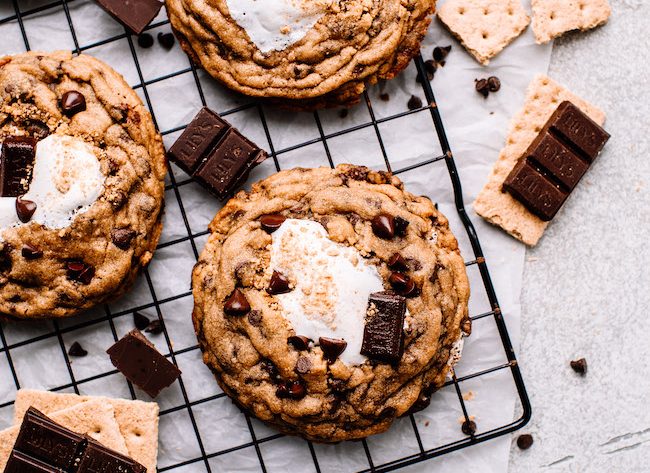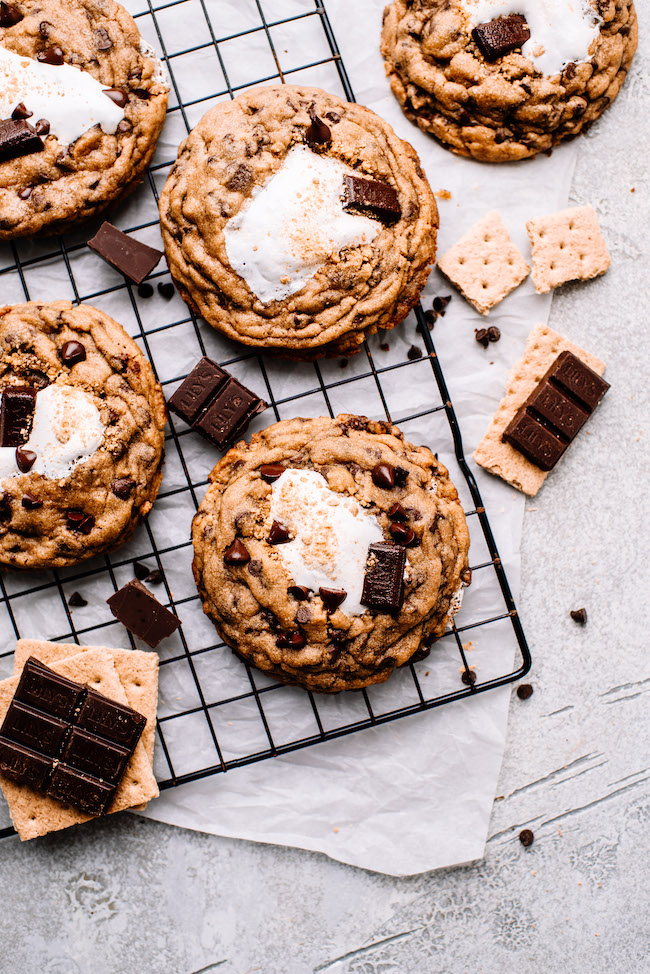Cookies add a delightful touch to any brunch spread, making it even more memorable and satisfying. Their versatility and delectable flavors make them a perfect addition to the brunch menu. From classic chocolate chip cookies to buttery shortbread or delicate macarons, there is a cookie to suit every palate. They can be enjoyed alongside a cup of coffee or tea, providing a sweet and indulgent treat to start the day. Cookies offer a wonderful balance of texture, with a crisp exterior and a tender, melt-in-your-mouth center. Their compact size makes them easy to grab and enjoy while mingling with friends and family. Whether you’re hosting a brunch gathering or attending one, cookies bring a touch of comfort and familiarity to the table, infusing the occasion with a sense of warmth and joy.
This American cookie recipe is sure to please young and old alike. It’s quick and easy to make, perfect for a weekend family activity or a fun brunch with friends.
Why do people love S’mores cookies so much?
People are absolutely smitten with Cookie S’mores, and it’s not difficult to see why. These delectable treats perfectly blend the nostalgic charm of traditional s’mores with the irresistible allure of freshly baked cookies. The combination of a gooey, toasted marshmallow nestled between two warm, soft cookies creates a symphony of flavors and textures that sends taste buds into a frenzy. Each bite is a harmonious balance of sweet and savory, with the rich, melted chocolate oozing out to enhance the experience further. The sheer joy and indulgence that Cookie S’mores provide transport people back to carefree campfire nights and evoke a sense of comfort and happiness. Whether enjoyed as a dessert, a snack, or simply as a fun treat, the love for Cookie S’mores is fueled by their ability to evoke cherished memories and create new ones with every mouthwatering bite.
How to avoid cookies spreading in the oven?
It’s always terrible when cookies spread in the oven and the pan looks like a giant cookie.
To prevent cookies from spreading excessively in the oven, you can follow these tips:
- Chilled dough: Refrigerate the cookie dough for at least 30 minutes or even overnight before baking. This allows the fats in the dough to solidify, resulting in less spreading during baking.
- Proper flour measurement: Use the appropriate amount of flour called for in the recipe. Too little flour can cause the dough to be too soft and spread more.
- Use cold ingredients: Make sure the butter is cool, not soft or melted, when mixing it with the other ingredients. Using cold eggs can also help reduce spreading.
- Parchment paper or silicone baking mats: Line your baking sheet with parchment paper or silicone baking mats. These provide a non-stick surface and can help limit spreading.
- Proper spacing: Leave enough space between each cookie on the baking sheet. Typically, about 2 inches apart should be sufficient to allow for spreading without the cookies merging together.
- Preheated oven: Ensure that your oven is fully preheated to the correct temperature before placing the cookies inside. This helps the dough set quickly and reduces spreading.
- Baking sheet temperature: Allow the baking sheet to cool down between batches. Using a hot baking sheet can cause the dough to melt and spread excessively.
- Adjust oven temperature and baking time: If you’ve tried all the above steps and still experience excessive spreading, you can try reducing the oven temperature slightly and/or increasing the baking time. This allows the cookies to set more gradually, minimizing spreading.
By implementing these techniques, you can control the spread of your cookies and achieve the desired thickness and shape.
Can cookies stick to foil and how to avoid that?
Cookies can sometimes stick to foil, especially if the foil is not properly prepared or if the cookies are very sticky or delicate. However, there are a few steps you can take to minimize the chances of cookies sticking to foil:
- Use non-stick foil: Non-stick foil has a special coating that reduces sticking. If you have non-stick foil available, it can be a good option for baking cookies.
- Grease or spray the foil: Lightly grease or spray the foil with non-stick cooking spray before placing the cookie dough. This creates a barrier between the dough and the foil, reducing the chances of sticking.
- Use parchment paper: Parchment paper is often a better choice than foil when it comes to baking cookies. It provides a non-stick surface and is widely used for baking purposes. Simply place a sheet of parchment paper on the baking sheet and arrange the cookie dough on top of it.
- Allow cookies to cool before removing: After baking, let the cookies cool on the foil for a few minutes before attempting to remove them. This allows them to set and firm up, making it easier to lift them off without sticking.
- Use a spatula: When removing the cookies from the foil, use a thin spatula or a cookie lifter to gently lift them off the surface. Slide the spatula underneath the cookie to release it from the foil without causing any damage.
How to make cookie s’mores?
Voila, your brunch recipe is ready. You can enjoy your s’mores cookies with a glass of milk.
Can cookies mold?
Yes, cookies can mold under certain conditions. Mold is a type of fungus that thrives in warm, damp environments, and cookies that are exposed to moisture can become susceptible to mold growth. Moisture can come from various sources, such as high humidity, improper storage, or ingredients that contain moisture (e.g., fruits, fillings, or frostings).
To prevent cookies from molding, it is important to store them properly. Here are some tips:
- Ensure cookies are completely cooled before storing them.
- Store cookies in an airtight container or a resealable plastic bag to limit exposure to moisture and air.
- Place a sheet of parchment paper or wax paper between layers of cookies to prevent them from sticking together.
- Keep cookies in a cool, dry place, away from direct sunlight and heat sources.
- Avoid storing cookies in areas with high humidity, such as the refrigerator, as condensation can develop and promote mold growth.
- Check stored cookies periodically for any signs of mold or spoilage. If you notice any, discard the affected cookies and thoroughly clean the storage container.




